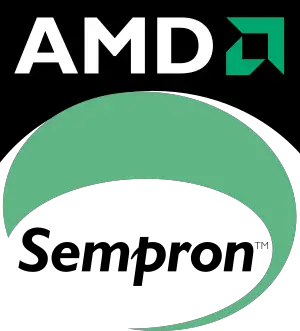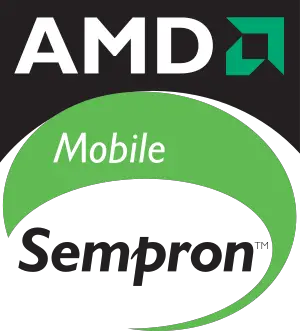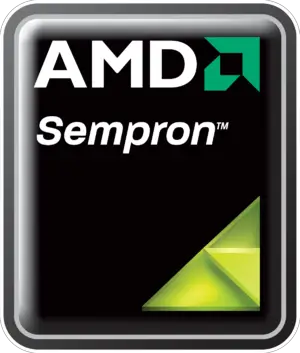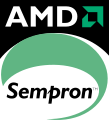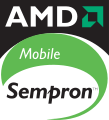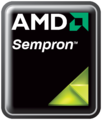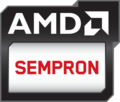| AMD Sempron | |
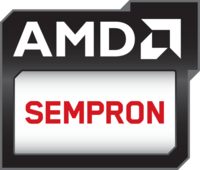
| |
| Past and current logos | |
| Developer | AMD |
| Manufacturer | AMD |
| Type | Microprocessors |
| Introduction | July 28, 2004 (announced) July 28, 2004 (launch) |
| Production | 2004 |
| ISA | IA-32, x86-64 |
| µarch | K7, K8, K10 |
| Word size | 32 bit 4 octets , 64 bit8 nibbles 8 octets
16 nibbles |
| Process | 130 nm 0.13 μm , 90 nm1.3e-4 mm 0.09 μm , 65 nm9.0e-5 mm 0.065 μm
6.5e-5 mm |
| Technology | CMOS |
| Succession | |
| ← | → |
| Duron | V |
Sempron is a family of budget 32-bit x86 microprocessors developed by AMD and introduced in early 2004, superseding the Duron family.
Contents
[hide]Overview
Since 1999, with the introduction of the K7-based Athlon (and its budget variant Duron), AMD has managed to compete with Intel head-to-head fairly well.
On July 28, 2004 AMD introduced their Sempron family of processors as a successor to the Duron family. The name is derivative of the Latin word "Semper" meaning "always". The name is meant to imply these processors are strong, robust. AMD suggested Sempron meant for "daily use, practical, and part of everyday life".
Member
K7-based Processors
- Main article: K7 Microarchitecture
As AMD did with Duron, the original Sempron family was K7-based on the Athlon XP's Thoroughbred and Thorton cores. Both cores have the same base features as their desktop XP counterparts and are limited to Socket A motherboards.
| This section is empty; you can help add the missing info by editing this page. |
K8-based Processors
- Main article: K8 Microarchitecture
| This section is empty; you can help add the missing info by editing this page. |
Sempron 64
| This section is empty; you can help add the missing info by editing this page. |
Sempron X2
| This section is empty; you can help add the missing info by editing this page. |
K10-based Processors
- Main article: K10 Microarchitecture
| This section is empty; you can help add the missing info by editing this page. |
Sempron X2
| This section is empty; you can help add the missing info by editing this page. |
Logos
Sempron Family
| AMD Sempron Processor Family | |||||
|---|---|---|---|---|---|
| Logo | Process (nm) | Architecture | Codename | Socket | Date released |
| Desktop | |||||

|
130 nm 130 nm 130 nm 130 nm 90 nm 90 nm |
K7 K7 K7 K8 K8 K8 |
Thoroughbred B (2200+ ÷ 2800+) Thorton (2200+ ÷ 2800+) Barton (3000+, 3300+) Paris (3000+, 3100+) Palermo (2500+ ÷ 3500+) Manila (2800+ ÷ 3800+) |
Socket A (Socket 462) Socket A (Socket 462) Socket A (Socket 462) Socket 754 Socket 754, Socket 939 Socket AM2 |
Jul 2004 Aug 2004 Sep 2004 Jul 2004 Aug 2004 May 2006 |

|
65 nm 65 nm 45 nm |
K8 K8 K10 |
Sparta (LE-1100 ÷ LE-1300) Brisbane (Sempron X2 2100 ÷ 2300) Sargas (130 ÷ 150), Regor (180, 190) |
Socket AM2 Socket AM2 Socket AM3 |
Aug 2007 Mar 2008 July 2009 |
| Laptop | |||||

|
130 nm 130 nm 90 nm 90 nm 90 nm 90 nm |
K8 K8 K8 K8 K8 K8 |
Dublin (2600+ ÷ 3000+) Georgetown (2600+ ÷ 3300+) Sonora (2600+ ÷ 3100+) Albany (3000+ ÷ 3600+) Roma (2800+ ÷ 3400+) Keene (3200+ ÷ 3600+) |
Socket 754 Socket 754 Socket 754 Socket 754 Socket 754 Socket S1 (638) |
Jul 2004 May 2005 Nov 2004 Jul 2005 Jul 2005 May 2006 |

|
65 nm 65 nm 65 nm 32 nm 32 nm |
Mobile Mobile Mobile Piledriver Piledriver |
Sherman (3600+ ÷ 4000+) Sable (SI-40, SI-42) Huron (200U, 210U) Trinity (Sempron X2 240) Richland (Sempron X2 250) |
Socket S1 (638) Socket S1 (638) Package ASB1 (BGA) Socket FM2/FM2+ Socket FM2/FM2+ |
May 2007 Jun 2008 Jan 2009 2010 2010 |
| List of AMD Sempron microprocessors | |||||
| designer | AMD + |
| first announced | July 28, 2004 + |
| first launched | July 28, 2004 + |
| full page name | amd/sempron + |
| instance of | microprocessor family + |
| instruction set architecture | IA-32 + and x86-64 + |
| main designer | AMD + |
| manufacturer | AMD + |
| microarchitecture | K7 +, K8 + and K10 + |
| name | AMD Sempron + |
| process | 130 nm (0.13 μm, 1.3e-4 mm) +, 90 nm (0.09 μm, 9.0e-5 mm) + and 65 nm (0.065 μm, 6.5e-5 mm) + |
| technology | CMOS + |
| word size | 32 bit (4 octets, 8 nibbles) + and 64 bit (8 octets, 16 nibbles) + |
